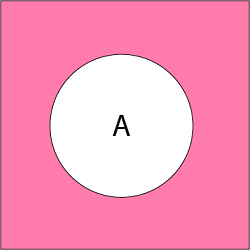Complement of Set
If U is a universal set and X is any subset of U then the complement of X is the set of all elements of the set U apart from the elements of X.
X′ = {a : a ∈ U and a ∉ A}
Venn Diagram

Examples
1. Let U be the set of all natural numbers.
A = {1, 2, 3}
Ac = {all natural numbers except 1, 2, and 3}.
2. If A = { 1, 2, 3, 4} and U = { 1, 2, 3, 4, 5, 6, 7, 8} then find A complement ( A’).
Solution :
A = { 1, 2, 3, 4} and Universal set = U = { 1, 2, 3, 4, 5, 6, 7, 8}
Complement of set A contains the elements present in universal set but not in set A.
Elements are 5, 6, 7, 8.
∴ A complement = A’ = { 5, 6, 7, 8}.
3. If B = { x | x is a book on Algebra in your library} . Find B’.
Solution : B’ = { x | x is a book in your library and x ∉ B }
4. If A = { 1, 2, 3, 4, 5 } and U = N , then find A’.
Solution :
A = { 1, 2, 3, 4, 5 }
U = N
⇒ U = { 1, 2, 3, 4, 5, 6, 7, 8, 9,10,… }
A’ = { 6, 7, 8, 9, 10, … }
5. If A = { x | x is a multiple of 3, x ∉ N }. Find A’.
Solution :
As a convention, x ∉ N in the bracket indicates N is the universal set.
N = U = { 1, 2, 3, 4, 5, 6, 7, 8, 9, 10,11, … }
A = { x | x is a multiple of 3, x ∉ N }
A = { 3, 6, 9, 12, 15, … }
So, A’ = { 1, 2, 4, 5, 7, 8, 10,11, … }
Some Properties of Complement Sets
1) A ∪ A′ = U
2) A ∩ A′ = Ø
3) Law of double complement : (A′ )′ = A
4) Laws of empty set and universal set Ø‘ = U and U′ = Ø.